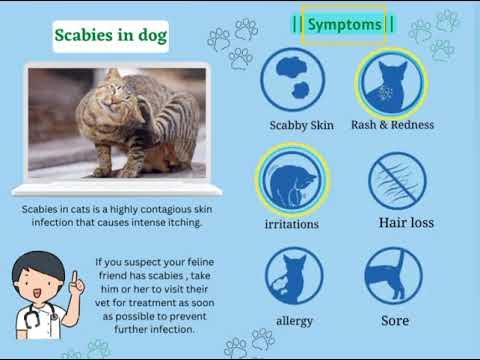FELINE SCABIES : DIAGNOSIS ,TREATMENT & PREVENTIVE CARE
Mange is a common infectious dermatological disease in animals. Some mange infections are zoonotic. There is a vast variety of mites, which are arthropods that comes under class Arachnida. There are more than fifty thousand species in this class. Subclass acri comprises two major lineages, parasitiforms and acariforms. Trombidiiformes and Sarcoptiformes lineages within the Acariformes contain mange mites. Trombidiiformes includes the major suborder Prostigmata, which contains many families, five of which contain mange mites. Sarcoptiformes Psoroptidia contains mange mites (OIE manual 2019) [9] . The majority of the infectious dermatological condition in felines in India is related to mites mainly Notoedrescati (Kumar et al. 2013). Feline scabies seems to be a highly contagious disease of dermatological importance. Ivermectin is extensively used against this condition. But increasing resistance and a great level of contraindications cause more limitations to the usage of this medicine. Selamectin is a semi-synthetic antiparasitic drug of avermectin group. This is structurally similar to ivermectin but fewer contraindications and greater safety make selamectin an ideal drug to treat cats with scabies and other parasitic skin disorders.
Cats can be affected by two types of scabies mites:
- Notoedres cati (feline scabies)
- Sarcoptes scabiei (canine scabies)
FELINE SCABIES IS A HIGHLY CONTAGIOUS PARASITIC SKIN DISEASE caused by the obligate parasite Notoedres cati, a mite that can only survive a few days off the host.
It has a worldwide distribution but is generally considered to be rare, with pockets of endemic infection in continental Europe for example. In the UK the mite was very common in the 1940s and 1950s but has virtually disappeared since (Thomsett and Baker, 1990).
With the advent of pet travel there is a small risk of acquiring the disease.
- Notoedres cati is a member of the sarcoptiform family.
- In appearance it is very similar to other members of the family such as Sarcoptes scabiei var canis of the dog with some differences.
- Notoedres is smaller and the eggs are round (Paterson, 2008).
- The two pairs of anterior legs have long-medium length unjointed stalks with suckers and the two posterior legs do not extend beyond the borders of the body, which is striated.
- The most notable distinguishing feature of Notoedres cati is that unlike Sarcoptes scabiei, which has a terminal anus, it has a dorsal anus.
- It is important to distinguish between the two species as Sarcoptes occasionally affects cats and may have a poorer prognosis as described under differential diagnosis.
Clinical signs
- The disease is extremely pruritic and as it progresses will not respond to glucocorticoids.
- Lesions begin on the medial side of the pinnal edge with a rapid spread to the face, eyelids, neck and become more generalised if not treated.
- Affected animals sometimes resemble “battle scarred tom cats” (Thomsett and Baker, 1990).
- Lesions are crusts – yellowish to grey in colour and the skin becomes thickened.
- Excoriation due to severe pruritus.
- Emaciation, anorexia and death is possible.
- Transient pruritic lesions in humans are common. Spread to other animals such as dogs and rabbits is also possible.
Differential diagnosis
- Otodectes cynotis – especially associated with hypersensitivity to the mite.
- Hypersensitivity – flea bites, food or atopy.
- Demodex gatoi.
- Autoimmune diseases – pemphigus foliaceus.
- Sarcoptes scabiei var canis. Cats appear to be resistant to infestation from contact with a canine scabies case. Occasional cases do present themselves in the UK (Hardy and others, 2012). These cats are extremely pruritic with generalised scaling.
There is often an abundance of mites demonstrated by skin scrapings or tape strips. Mites in these patients will have a terminal anus, important in the differential diagnosis. There is often an underlying immunosuppression and attempts should be made to diagnose this and treat it if possible, otherwise cure will be difficult.
Diagnosis
- The history and physical examination is very suggestive, with human lesions, failure to respond to glucocorticoids and rapid spread being important clues.
- Tape strips. These should be employed first as they are easy to do and are minimally resented. A transparent tape strip is pressed against lesion areas and transferred to a slide.
- Skin scrapings.
- With either technique, mites are usually easy to find – much more so than with the canine disease. Therefore a therapeutic trial is rarely necessary, although not to be discounted if doubt exists.
Treatment
- Treatment is generally effective according to experience in those countries where the disease is present. Products that are used to treat canine scabies should be effective and three are mentioned here.
- 2% lime sulphur dips (Dechra). Between six to eight weekly applications may be necessary.
- Selamectin (Stronghold, Zoetis). This is applied as a spot-on at 30-day intervals for three applications. It is preferable that the professional staff of the clinic perform this to eliminate any possibility of poor compliance, particularly in the rare case where the treatment is a trial therapy.
- Fipronil (Merial Animal Health.) Applied as a spot-on or spray.
- Glucocorticoids will help alleviate the extreme pruritus but should only be used short-term and after there has been a definitive diagnosis.
Compiled & Shared by- This paper is a compilation of groupwork provided by the
Team, LITD (Livestock Institute of Training & Development)
Image-Courtesy-Google
Reference-On Request.


